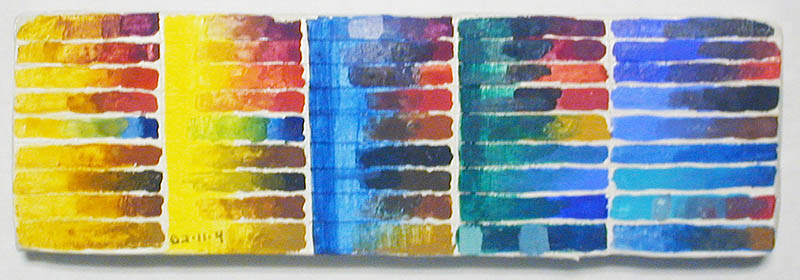|
6 COLOR BLENDS, TEST CHART, 02-11-04
There are several ways to lighten color, today I want to get more carbonate forming on the surface. I'll start with one pigment and one lime putty, that should do it. That visually lightens the color about 10% while wet. 04-14-04, This is what I learned when the colors dry, a week later the color is 20 to 30% lighter. There is a big loss of contrast, most change happens in the first week. Don't use lime cream or paste in dark colors, use lime water. Paint the dark colors first so they have time to absorb. Titanium white is very opaque, you get the tint color you mix wet when it's dry. The mortar was still not hard after 5 days. Steve said he saw it hard in 2 days by mixing all his pigments in lime paste but he is working in normal weather, it's very wet here. It might be just that simple. So why was neutral lime pigment called the best white? It was the best white they had at the time.

Lots of nice darks! Quinacridone Red mixes with Cad yellow better than Cad Red. Indian yellow paints better with a little lime putty or lime milk. The color are soaking in slowly, it's too easy to remove the last coat, bad for blending, I'm switching to pure lime water starting with the Thalo Blue column. Now I think it's the marble meal making it slower to absorb. The mortar is still soft enough to move with my finger so I know I'm not past the fresco time. Now I know it was the wet weather. First Thalo Blue pure, than with lime putty. A dry soft stippling goat hair brush helps blending. Quinacridone Magenta has got to be reground between uses for it's best color. Raw Umber is a lighter valued yellow brown, Burnt Umber is darker on the red side. Just like the RCW. Raw Sienna is as grainy as Pozzouli Red and Yellow Oxide. Thalo Green needs alcohol to dissolve, let the alcohol evaporate on the palette and use limewater medium, add Quinacridone Magenta to make a good black. Starting with Thalo Green and Cerulean I'm testing egg secco. Wow, it's like night and day, the blends are easy, the under coat doesn't pick up. Painting is fun again! I even put a stroke with titanium in the Thalo Green to Thalo Blue to see how close it comes to Cobalt Turquoise, which is still holding it's own in the lime jar test after twenty days. Egg leaves a high shine. Once a stroke sets with egg you can't put another coat on top of it in fresco or secco. Don't use egg on wet buon fresco, just lime water. For secco use casein, it stays flat finish, egg adds shine. 15 days later, all of these pigments are lime safe. 
|